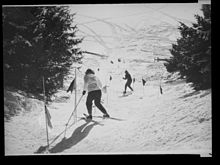Stem christie
| Skiing techniques |
|---|

The stem christie or "wedge christie" is a technique used in skiing for turning. The turn comprises three steps: 1. Forming a wedge by rotating the tail of one ski outwards at an angle to the direction of movement, which initiates a change in direction opposite to the stemmed ski. 2. Bringing the other ski parallel to the wedged ski. 3. Completing the turn with both skis parallel as they carve an arcing turn sliding sideways together.[1]
History
Austrian ski guide Hannes Schneider developed the stem christie. Having perfected it by 1910 he promoted it as the mainstay of the Arlberg technique, which he called the "Alpine System". It replaced the Telemark turn as the standard for descending on skis.[1] The technique was widely used up until the late 1960s, when its use diminished in favor of the parallel turn. Skis with increasingly "parabolic sidecut" accelerated the obsolescence of the stem Christie, starting in the late 1990s, because of their improved turning characteristics over skis with minimal sidecut.[2]
The term, "christie", derives from the turning technique employed by Norwegian jumpers in Christiania, Norway[a], which was called the "stem Christiania" and became shortened to "stem christie".[1]
See also
- Snowplough turn - also known as the wedge turn or stem turn
- Parallel turn
- Skiing Topics
Notes
References
- ^ a b c Pfeiffer, Doug (January 1969). "Instruction Corner—Back to Basics: Edge Control". Skiing. 20 (4). Chicago: Ziff-Davis: 94. ISSN 0037-6264. Retrieved 2016-11-06.
- ^ Johanna Hall (Winter 1997). "All Mixed Up? - How To Make Sense Of The Multi-Shaped Lesson". Archived from the original on April 11, 2003. Retrieved 2013-12-14.
{{cite web}}: Unknown parameter|deadurl=ignored (|url-status=suggested) (help)
